Index of Books And Instructional Aids We Recommend

SOME OF THE BOOKS AND INSTRUCTIONAL AIDS RECOMMENDED HIGHLY BY COMPANY SEVEN
Our Laurel, Maryland showroom stocks a broad selection of books about astronomy and related equipment including star charts, software, and observing guides. While many of these titles go in and out of stock from day to day, the titles below are considered so important by our staff that we work even more diligently to ensure these titles are always in stock - at least as long as they are in print. Feel free to contact us to discuss what titles may help you best, and of course Company Seven can arrange delivery to you by mail order to almost any destination around the world.
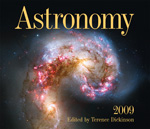 Astronomy 2013 (2009 shown, updated annually): wall calendar by Terrence Dickinson. Among the few annual publications which Company Seven recommends to those persons who are new to the hobby and seek a combination of inspiration and tips on what to see and when. This is most popular among our customers who are new to the hobby and seek a combination of inspiration and tips on what to see and when, and it is often bought as a gift.
Astronomy 2013 (2009 shown, updated annually): wall calendar by Terrence Dickinson. Among the few annual publications which Company Seven recommends to those persons who are new to the hobby and seek a combination of inspiration and tips on what to see and when. This is most popular among our customers who are new to the hobby and seek a combination of inspiration and tips on what to see and when, and it is often bought as a gift.
This product is revised annually so that it provides the latest information about known coming celestial events. And each month's calendar is headed with one of the twelve (12) amazing color astrophotographs contributed by NASA, and by amateur and professional astronomers.
The images, their printing and content are first rate!
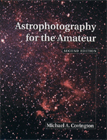 Astrophotography for the Amateur: Softcover by Michael A. Covington is recommended to those persons who own or wish to acquire a telescope or other equipment that may be suitable for astrophotography. This book will instruct you about how to attach a film camera or digital camera to a telescope to capture images of what may be seen - or which may otherwise be invisible! It will also teach you what may be accomplished with relatively simple camera equipment. "Astrophotography for the Amateur" is a concise guide about taking photographs of the stars and star clusters, galaxies, the sun, the moon, comets, meteors, and eclipses.
Astrophotography for the Amateur: Softcover by Michael A. Covington is recommended to those persons who own or wish to acquire a telescope or other equipment that may be suitable for astrophotography. This book will instruct you about how to attach a film camera or digital camera to a telescope to capture images of what may be seen - or which may otherwise be invisible! It will also teach you what may be accomplished with relatively simple camera equipment. "Astrophotography for the Amateur" is a concise guide about taking photographs of the stars and star clusters, galaxies, the sun, the moon, comets, meteors, and eclipses.
It is written and illustrated in such a manner that anyone from junior high/middle school to the experienced amateur astronomer will find the book readable, interesting, and informative. This is the most comprehensive and among the more up to date of the books written specifically for amateurs who may be beginning astrophotography, but it will also help others who have been involved in photography improve, and progress into new areas and techniques.
 The Backyard Astronomer's Guide: 3rd Edition Revised and Expanded, 2008. Hardback, by Terrence Dickinson and Alan Dyer. Also one of the few books which Company Seven recommends to those persons who have decided to buy a telescope in the near future, and who are now considering the choice of astronomical telescope, binoculars, and the related accessories.
The Backyard Astronomer's Guide: 3rd Edition Revised and Expanded, 2008. Hardback, by Terrence Dickinson and Alan Dyer. Also one of the few books which Company Seven recommends to those persons who have decided to buy a telescope in the near future, and who are now considering the choice of astronomical telescope, binoculars, and the related accessories.
This is an up to date book which is helpful in getting you started in astronomy by naked eye, or with binoculars, and it is very helpful in choosing a telescope before you buy. It will also help you to progress with the telescope over the first year or two using the telescope. Furthermore, it is written and illustrated in such a manner that anyone from upper elementary school to the experienced amateur astronomer will find the book readable, interesting, and informative.
This edition is a complete rewrite of the original work of 1991 and 2002 editions, so this new edition includes discussions of aspects of the hobby that were not even contemplated when the original work was published.
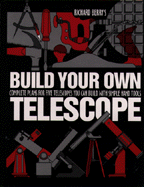 Build Your Own Telescope: Hardback, by Richard Berry: is one the first books which Company Seven recommends to those persons who are considering the decision of whether or not to build an astronomical telescope, or who have decided to build a telescope. In clear, step-by-step instructions, author Richard Berry explains how to build five telescopes from a simple reflecting telescope suitable for a parent with a small child, up to a "research-grade" 10 inch Newtonian reflecting telescope capable of sustaining a lifetime's interest in astronomy. The detailed instructions include complete plans and photographs that show how to construct these capable telescope using ordinary household tools and materials.
Build Your Own Telescope: Hardback, by Richard Berry: is one the first books which Company Seven recommends to those persons who are considering the decision of whether or not to build an astronomical telescope, or who have decided to build a telescope. In clear, step-by-step instructions, author Richard Berry explains how to build five telescopes from a simple reflecting telescope suitable for a parent with a small child, up to a "research-grade" 10 inch Newtonian reflecting telescope capable of sustaining a lifetime's interest in astronomy. The detailed instructions include complete plans and photographs that show how to construct these capable telescope using ordinary household tools and materials.
"Build Your Own Telescope" includes complete plans, step-by-step instructions with 275 illustrations that show you how to build these five telescopes:
- 4 inch aperture f/10 Reflector: A sturdy and easy-to-use telescope that is perfect for beginners or as a parent/child project.
- 6 inch f/8 Dobsonian Reflector: A light, compact telescope that is simple to build, but powerful enough to satisfy a backyard observer for many years.
- 6 inch f/8 Equatorial Reflector: A classic design for the amateur astronomer or craftsman who wants an elegant telescope and great performance.
- 10 inch f/6 Dobsonian Reflector: A powerful and versatile telescope suitable for casual stargazing or for a serious amateurs long-term observing programs.
- 6 inch f/1 5 Refractor: A large refractor that outperforms commercial telescopes of considerably larger aperture.
Many of the principles can be applied to building many other telescopes not specifically covered in this publication. We also suggest this for use in guiding children who are doing such a task as a science fair project. It is written and illustrated so that anyone between a teenage novice to the adult amateur astronomer will find the book interesting, and helpful.
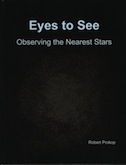 The book Eyes To See: Observing the Nearest Stars. Looking up into the Heavens on a clear night under a dark sky, we can easily fool ourselves into thinking that the brightest stars we see are those closest to us. The reality could not be more different! In fact, 19 of the 25 closest stars to the Sun are invisible to our naked eye, and many are actually so faint that even with the modest equipment owned by most amateur astronomers, they can be supremely difficult to find. Eyes To See: Observing the Nearest Stars takes the reader on a one-year guided tour through the regions of the Milky Way galaxy closest to our own solar system, concentrating on practical hints at observing this region for one's self. Sixty-three (63) color illustrations and detailed star charts guide the viewer to find for themselves every star within 12 light years of the sun and visible from the Continental United States.
The book Eyes To See: Observing the Nearest Stars. Looking up into the Heavens on a clear night under a dark sky, we can easily fool ourselves into thinking that the brightest stars we see are those closest to us. The reality could not be more different! In fact, 19 of the 25 closest stars to the Sun are invisible to our naked eye, and many are actually so faint that even with the modest equipment owned by most amateur astronomers, they can be supremely difficult to find. Eyes To See: Observing the Nearest Stars takes the reader on a one-year guided tour through the regions of the Milky Way galaxy closest to our own solar system, concentrating on practical hints at observing this region for one's self. Sixty-three (63) color illustrations and detailed star charts guide the viewer to find for themselves every star within 12 light years of the sun and visible from the Continental United States.
This is written by a customer of Company Seven, who got his start into visual astronomy not too many years ago. He progressed from a small to a mid size Williams Optics 5 inch Apo refractor on a simple Universal Astronomics alt-azimuth mount with tripod.
If you are not familiar with finding your way around the night sky then Company Seven recommends you buy a good simple Planisphere to accompany this book. We sell some that are favored by us including David H. Levy Guide to the Stars Planisphere, listed below, that are durable and easy to read with a red light at night. These instruments drew his interest and stoked his passion for the hobby of visual astronomy, and in this book he reflects not only on the practicalities of observing as he guides you through the night sky, by how this hobby came at a critical juncture of his life. So this is an excellent read not only for those seeking a guide to how to find some interesting stars in the night sky and their history, but about how astronomy just might help you to find yourself.
This is another of those wonderful books that are difficult to find in a store. Company Seven found it to be such a practical and enjoyable read and reference work, that is also thought-provoking on several other levels too so that we wish to share this with our friends. We will make a special effort to stock this title, and to make it available as a .pdf title for those who seek such portability and convenience.
 DVD "How to Become An Expert Solar Imager" The Sun has been a subject of awe, respect and worship, fear and study since the dawn of time. Early astronomers too wondered at it, and many were blinded (including Galileo) by employing unsafe filtering techniques to look directly at the Sun. It is only over the recent generations that mankind has developed the technology to reveal the Sun with complete safety, and to capture images of it in all its magnificent diversity. This technology has now become attainable by the amateur and it reveals a constantly changing, in motion star; one of the few celestial wonders that changes right before your eyes.
DVD "How to Become An Expert Solar Imager" The Sun has been a subject of awe, respect and worship, fear and study since the dawn of time. Early astronomers too wondered at it, and many were blinded (including Galileo) by employing unsafe filtering techniques to look directly at the Sun. It is only over the recent generations that mankind has developed the technology to reveal the Sun with complete safety, and to capture images of it in all its magnificent diversity. This technology has now become attainable by the amateur and it reveals a constantly changing, in motion star; one of the few celestial wonders that changes right before your eyes.
The DVD How to Become An Expert Solar Imager is a comprehensive tutorial about how to image the Sun, and process the images captured to attain results like the professionals do. The materials within the DVD How to Become An Expert Solar Imager will teach you how to not only capture images of the Sun but it also provides instruction about how to process images, just like the professionals do, to colorize monochromatic images, to achieve a dramatic result, or clarify subtle details. So with the proper equipment and this instruction you too can experience the Sun and produce amazing results: the Sun can be your object of study or of art.
This instructional DVD resulted from a collaborative effort by Ninian Boyle and Pete Lawrence, two experienced amateurs who are using solar filtered telescopes the same as those you can buy from Company Seven. They produced this DVD to answer these questions and many more besides. Their work has featured prominently in works by the BBC (British Broadcasting Corporation) as well as in advertisements for companies that manufacture equipment for amateurs and professionals including Coronado and Solarscope, Ltd. for example.
This is another of those resources that are difficult to find to order online, and that is presently not sold by any other store in the Americas. Company Seven found this video insightful, particularly for those who may just getting started into imaging the Sun; those who are already taking good images may produce even better results after studying this tutorial. Company Seven makes a special effort to stock this DVD at our showroom, we make it available to those in the Americas who cannot visit our showroom through our on line ordering 'Buy It Now'.
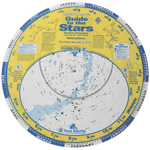 The David H. Levy Guide to the Stars Planisphere. The night sky is mapped with the Constellations being those patterns recognizable to man since time immemorial. Constellations can be thought of as countries or states on a world map, where if you seek the Grand Canyon then you know to find Arizona. While in the night sky when one seeks the Great Nebula then one looks toward the Constellation Orion. The Planisphere is the simplest device with which to start ones' trek into the night sky.
The David H. Levy Guide to the Stars Planisphere. The night sky is mapped with the Constellations being those patterns recognizable to man since time immemorial. Constellations can be thought of as countries or states on a world map, where if you seek the Grand Canyon then you know to find Arizona. While in the night sky when one seeks the Great Nebula then one looks toward the Constellation Orion. The Planisphere is the simplest device with which to start ones' trek into the night sky.
If you are not familiar with the night sky then Company Seven recommends you buy a good simple Planisphere. We sell some that are favored by us including these made by "Graun Press" in the USA that are durable and easy to read with a red light at night.
The Planisphere makes it very easy for one to find out what constellations and major deep sky objects are up overhead at any given time of the day or night. These are made in two sizes 11 or 16 inch diameter, available in either English or Spanish, and for use in either Northern or Southern Hemispheres. These are a two piece plastic disc assembly with a map of the entire night sky on the rear chart disc, and another overlay disc attached over the chart disc. The overlay has a transparent window with a surrounding mask to simulate the North, South, East and West horizons. The overlay is dialed to line up its local time indicator marks with the Month and Day printed around the edge of the chart disc, and so when properly set this will reveal what parts of the sky may be seen at any time of the year. We prefer the larger 16 inch model because the writing is larger and easer to read under red flashlight. The print is black lettering against a white background sky and is easy to read under red light.
Note, a Planisphere made for use in the Northern Hemisphere is not useful in the Australia for example. If you ever plan to travel south then you should buy one for the lower hemisphere since the skies there are so different than in the North.
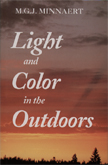 Light and Color in the Outdoors: Hardcover, by Marcel Gilles Josef Minnaert (b. 1893, d. 1970): a classic book accompanying the reader on a tour of nature's light and color revealing the myriad phenomena that may be observed outdoors with no more than a pair of sharp eyes and an inquiring mind. From the intriguing shape of the dapples beneath a tree on a sunny day, to rainbows, mirages, and haloes, the "Green Flash" of an ocean view sunset, to the colors of liquid, ice, and the sky, to the appearance of the sun, moon, planets, and stars. Minnaert describes and explains them all in clear language accessible to the layman.
Light and Color in the Outdoors: Hardcover, by Marcel Gilles Josef Minnaert (b. 1893, d. 1970): a classic book accompanying the reader on a tour of nature's light and color revealing the myriad phenomena that may be observed outdoors with no more than a pair of sharp eyes and an inquiring mind. From the intriguing shape of the dapples beneath a tree on a sunny day, to rainbows, mirages, and haloes, the "Green Flash" of an ocean view sunset, to the colors of liquid, ice, and the sky, to the appearance of the sun, moon, planets, and stars. Minnaert describes and explains them all in clear language accessible to the layman.
The author's enthusiasm inspires the reader, who is encouraged and given the abundant opportunity to make his or her own observations and perform simple experiments. Yet the photographer, astronomer, or physicist will also find a wealth of detailed information, much unavailable elsewhere, about the more exotic phenomena assembled by Minnaert over the years. Among them are Sun dogs, the fata morgana, coronae, glories, noctilucent and iridescent clouds and haloes. This volume includes photographs, most in color, illustrating many of the phenomena - ordinary and exotic - discussed in the book.
With such a broad scope of appeal, we consider this an excellent gift for anyone with an appreciation of nature, or astronomy, or scientific methodology. This a book which is hard to find, but Company Seven finds it to be so fascinating and enjoyable to share with friends, and children that we have made special efforts to stock this title.
 Deep-Sky Companions: The Messier Objects If you ever wanted for a guide book which would provide not only good photographs, but also a realistic vision of how the most popular deep sky celestial objects may appear when viewed through a good amateur telescope (such as many sold by Company Seven) with very detailed observing summaries, then this is a book which you should consider.
Deep-Sky Companions: The Messier Objects If you ever wanted for a guide book which would provide not only good photographs, but also a realistic vision of how the most popular deep sky celestial objects may appear when viewed through a good amateur telescope (such as many sold by Company Seven) with very detailed observing summaries, then this is a book which you should consider.
The "Messier Catalog" is a list of Galaxies, emission and planetary Nebulae, and Star Clusters which were identified and cataloged between 1757 and 1784 by Charles Messier. A skilled observer employed at an observatory in Paris, in August 1758 Messier was searching for Comets when he came across a fuzzy spot in the night sky. He began to write a catalog with this object "M 1" (later known as the "Crab Nebulae"), he would add many more to his list over the remainder of his observing lifetime. One can argue Messier may have had better skies than we do today, but most amateurs now have telescopes and binoculars that he could not have imagined!
This is the book which Company Seven suggests to those who wish to start into deep sky (objects outside the Solar System) astronomy by naked eye, or with binoculars, and are very likely to buy a telescope. It is the best illustrated work on the subject, good and entertaining reading, and suitable for most children at Junior High/Middle School levels up to adults.
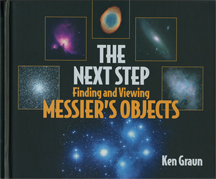 "The Next Step - Finding and Viewing Messier's Objects": First Edition 2005. Hardcover, by by Ken Graun: this is a convenient astronomy guide book written for the rest of us - those who may be newer to the hobby, or who appreciate a more fun approach to reading. "The Next Step, Finding and Viewing Messier's Objects" is a delightfully illustrated handy book with some beautiful color pictures, color illustrations and charts, and with black and white photo plates of the Messier Objects. The book features photos with visual descriptions by the author with a TeleVue 101 4 Inch f/5.4 and TeleVue 102 4 inch f/8.6 apochromat refracting telescopes.
"The Next Step - Finding and Viewing Messier's Objects": First Edition 2005. Hardcover, by by Ken Graun: this is a convenient astronomy guide book written for the rest of us - those who may be newer to the hobby, or who appreciate a more fun approach to reading. "The Next Step, Finding and Viewing Messier's Objects" is a delightfully illustrated handy book with some beautiful color pictures, color illustrations and charts, and with black and white photo plates of the Messier Objects. The book features photos with visual descriptions by the author with a TeleVue 101 4 Inch f/5.4 and TeleVue 102 4 inch f/8.6 apochromat refracting telescopes.
This book is an interesting read for those who appreciate the historical insights to the life of Charles Messier (b. 26 June 1730 in Lorraine France, d. 12 April 1817 in Paris), the French astronomer who gave us the Messier Objects catalog of celestial wonders. The author performed extensive research in the USA and overseas to accumulate the knowledge that he conveys in a very readable format.
"The Next Step" could be a good gift for someone interested in astronomy, and who has binoculars and or a reasonable first telescope at their disposal. Company Seven recommends this to those who wish to read an introduction to amateur telescopes and learn how to use them to star hop or navigate into these first hundred or so deep sky objects. It is well illustrated, good and entertaining reading, and suitable for most children at Junior High/Middle School levels up to adults.
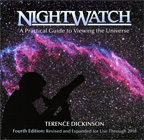 Nightwatch: Revised 2006 and reprinted 2008. Softcover spiral bound, by Terrence Dickinson: this is a among the best laid out, and written budding amateur astronomer's guide to understanding the night sky - it's motions, and how to find one's way around the night sky. Among the fascinating discussions is one about the relative size and relation of the planet Earth to our local planets and solar system, its relation to our Galaxy, and so on - one can begin to grasp the scale of the universe.
Nightwatch: Revised 2006 and reprinted 2008. Softcover spiral bound, by Terrence Dickinson: this is a among the best laid out, and written budding amateur astronomer's guide to understanding the night sky - it's motions, and how to find one's way around the night sky. Among the fascinating discussions is one about the relative size and relation of the planet Earth to our local planets and solar system, its relation to our Galaxy, and so on - one can begin to grasp the scale of the universe.
The spiral bound arrangement permits one the easy use of the included, simple to understand star charts of the night sky. These charts provide the basic information one will need to find their way around to the more obvious features of the night sky; and yet the charts are not cluttered with information, nor do they cover all areas of the night sky and so you may wish to buy a more detailed chart later as you progress into the hobby). The most important information on the color printed charts can be read with red flashlights commonly used by amateur astronomers (to preserve their "night vision"), the less important items are printed in red and these "disappear" under the red light used by most most experienced amateur astronomers (such as the Rigel Systems "Skylite") - cool! "Nightwatch" also contains brief discussions regarding the choosing and use of amateur astronomical telescopes, and with discussions of some of the most popular related accessories.
This is one of the few books which Company Seven suggests to those who wish to start into astronomy by naked eye, or with binoculars, and are considering whether or not to buy a telescope. It is very well illustrated, simple to comprehend so that an elementary school child could enjoy it and learn from it, and yet an adult does not feel like they are reading a simple "Dick and Jane" novel.
 Observer's Handbook: Softcover, by the Royal Astronomical Society of Canada. The "Observers Handbook" is one of Canada's oldest scientific publications. An annual publication, filled with information and interesting articles discussing most of the subjects which an amateur astronomer is likely to be concerned about including seeing concerns, observing, equipment, and detailed information about the objects in the sky (night and day).
Observer's Handbook: Softcover, by the Royal Astronomical Society of Canada. The "Observers Handbook" is one of Canada's oldest scientific publications. An annual publication, filled with information and interesting articles discussing most of the subjects which an amateur astronomer is likely to be concerned about including seeing concerns, observing, equipment, and detailed information about the objects in the sky (night and day).
The "Observer's Guide" includes discussions and drawings of periodic astronomical events that are known to be coming in that year, as well as good coverage of topics, and explanations of astronomical phenomena. Includes numerous tables, charts, and adequate line art illustrations.
This is the book which Company Seven suggests be taken into the field by those who already own, or are soon going to own a good astronomical telescope. With this book one can plan an observing or astrophotography session well in advance of the date of the event. This book is a valuable resource with tables, formulae, and numerous articles of advice about astronomical objects, optics, human vision. In one simple to use reference you can find out: how many moons does Jupiter have? (and read information about each). How big is the Sun? When will an object be in a good part of the sky to view or image? How to observe? And much more.
This is an excellent compliment to an optional star chart, and telescope/observing reference guide book such as "Starware" or "Backyard Astronomer's Guide".
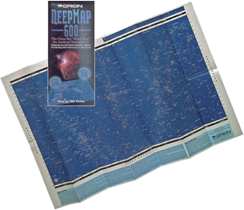
 Orion DeepMap 600: is a durable and handy folding plasticized Star Chart. This is among those indispensable publications that Company Seven recommends to those who are interested in learning their way around the night sky. Steve Peters, the editor of DeepMap 600, conceived of this chart of the night sky geared for customers who are new or moderately experienced to the hobby and who buy a telescope or binocular and now seek out what to see and when. Depending on how dark and clear your skies are, this is a good aid even for those just getting started with the naked eye.
Orion DeepMap 600: is a durable and handy folding plasticized Star Chart. This is among those indispensable publications that Company Seven recommends to those who are interested in learning their way around the night sky. Steve Peters, the editor of DeepMap 600, conceived of this chart of the night sky geared for customers who are new or moderately experienced to the hobby and who buy a telescope or binocular and now seek out what to see and when. Depending on how dark and clear your skies are, this is a good aid even for those just getting started with the naked eye.
Fully color illustrated, the DeepMap 600 shows the positions of more than six hundred of the finest celestial objects visible from the Northern Hemisphere plotted on a giant 33 x 21 inch full-color star chart by world-renowned celestial cartographer Wil Tirion. The material has been plasticized to repel dew and staining, hence it is very practical for use outdoors at night. The chart is easy to read, each of the objects are represented by a symbol so that they are easy to differentiate. You will preserve your night vision and see more of the night sky when reading this chart with an optional red flashlight. But what really makes this star chart invaluable is its convenience, it folds "accordion style" into a thin pocket-size 4-¾ x 10-½ inches format - just like a road map!
This is also a great idea as an economical but valued and durable gift.
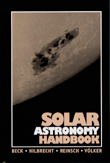 Solar Astronomy Handbook: Hardcover, by by Beck, Hilbrecht, Reinsch, and Volker: a handbook of Biblical proportions to observing, and photography of the Sun. A must read for anyone who anticipates viewing the Sun with relatively simple and inexpensive filters, or with the advanced Solar filters offered by Company Seven (such as the DayStar Hydrogen Alpha and Calcium K-Line filters. It will make any night time astronomer learn what can be accomplished with a telescope or simpler devices during the day. Illustrated in black and white, with numerous drawings and tables.
Solar Astronomy Handbook: Hardcover, by by Beck, Hilbrecht, Reinsch, and Volker: a handbook of Biblical proportions to observing, and photography of the Sun. A must read for anyone who anticipates viewing the Sun with relatively simple and inexpensive filters, or with the advanced Solar filters offered by Company Seven (such as the DayStar Hydrogen Alpha and Calcium K-Line filters. It will make any night time astronomer learn what can be accomplished with a telescope or simpler devices during the day. Illustrated in black and white, with numerous drawings and tables.
This book was conceived and written by a group of German amateur observers. Each section was the responsibility of the amateur who had made that aspect of solar astronomy his specialty. The emphasis was on the practical and covers the kind of solar astronomy within the reach of most amateurs. Soon after publication it was declared by many reviewers as the "standard work" and much correspondence reached the authors from abroad requesting an English translation. In terms of content the basic information in the original German edition will be found here. Where necessary, updating has taken place and errors have been corrected. Numerous passages were revised taking into account the larger, inter-national circle of readers, many pictures have been added and references to German-language literature have been changed, where possible, to appropriate English-language works.
The book describes instruments used in solar astronomy, offers help in making decisions with regard to buying, and provides instructions for those who might build their own instrument. It also deals with the many different amateur observation possibilities, gives encouragement and help in planning and carrying out expeditions to observe solar eclipses and gives details on observation, and is an extensive bibliography especially tailored for the amateur solar astronomer. Each chapter of the book is self-contained in terms of contents and the reader can turn to those subjects which interest him or her the most. Numerous cross-references are embedded within the text to point the reader to related sections.
 Star Testing Astronomical Telescopes: A Manual for Optical Evaluation and Adjustment, Second Edition Hardcover, by Harold Richard Suiter. Adequately illustrated in black and white, the amateur astronomers most practical guide to telescope optics.
Star Testing Astronomical Telescopes: A Manual for Optical Evaluation and Adjustment, Second Edition Hardcover, by Harold Richard Suiter. Adequately illustrated in black and white, the amateur astronomers most practical guide to telescope optics.
Released in 2009, the second edition of "Star Testing Astronomical Telescopes" is The Bible of telescope star testing and adjustment. This continues the fine tradition set by the first edition, but this adds even more information and presents it in ways that are more readily comprehended by a broader readership. It is a great choice for those who wish to better understand their telescopes, and possibly improve the performance of that telescope. It is recommended for those persons who have decided to buy an astronomical telescope, or for those who are now considering the choice of astronomical telescope. This is a book which can be most helpful when you receive a new telescope. It will teach you how to perform a simple "Star Test", a test method that can be used at the observing site, so that all the problems that impact on a telescope's optical performance can be diagnosed. This can help you determine if your new telescope has an optical gross anomaly that should justify its return for an exchange. And since most telescopes are roughly handled during shipping and they often arrive out of proper alignment, "Star Testing Astronomical Telescopes" teaches one how identify if a telescope is out of adjustment ("collimation"), and it will provide insights into how to remedy it.
Anyone from about High School age and older should find the book readable, interesting, and informative. "Star Testing Astronomical Telescopes" is concise, and well illustrated.
 Starware: Softcover, by Philip S. Harrington: adequately illustrated in black and white, the amateur astronomers guide to choosing, buying, and using telescopes and related accessories.
Starware: Softcover, by Philip S. Harrington: adequately illustrated in black and white, the amateur astronomers guide to choosing, buying, and using telescopes and related accessories.
This book "names names"; it briefly discusses specific telescopes manufacturers products which may be found on the market today. Chapters also include much practical advice as well as some explanation of theory, a bibliography of helpful publications and software, discussions about binoculars, telescope maintenance and collimation (alignment of the optics), telescope testing (since not all consumer telescopes are created equal), discussions regarding sky conditions (seeing, transparency, etc.), polar alignment and use of mechanical setting circles, with the last 20% or so of the book discussing celestial objects and how to observe them. Adequately supported with black and white illustrations and drawings.
This is one of only two of those up to date books which Company Seven suggests to those who have decided to buy a telescope, and who are now considering which choice of astronomical telescope and the related accessories to make.
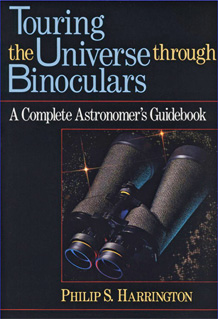 Touring The Universe Through Binoculars: Softcover, by Philip S. Harrington: illustrated in black and white, the amateur astronomers guide to choosing, buying, and using binoculars (hand held and tripod mounted) and related accessories for astronomy.
Touring The Universe Through Binoculars: Softcover, by Philip S. Harrington: illustrated in black and white, the amateur astronomers guide to choosing, buying, and using binoculars (hand held and tripod mounted) and related accessories for astronomy.
There is much that can be accomplished with binoculars to learn the night sky and observer a number of the brighter celestial objects. Company Seven has often some people think they may have some interest in the hobby, and who may already own a binocular that they have nothing to lose by pulling out a lawn chair and relaxing to the sights and wonders overhead with a simple chart and guide book. "Touring the Universe Through Binoculars" is one of only a few up to date books which Company Seven recommends to those persons who have decided to buy a binocular, and also seek information about the related accessories, and how to use binoculars to explore the night sky. This is a book which is helpful before you buy, and which can also help you to progress with the binocular on a night by night basis.
Incidentally we find it more than coincidental that the "poster child" of binoculars selected by Phil Harrington to grace the cover of his book are the highly regarded Fujinon 70 mm FMT-SX series large binoculars which are displayed and sold in our showroom, and ordered by our customers from around the world!
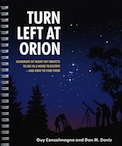 Turn Left at Orion: Hundreds of Night Sky Objects To See In A Home Telescope - And How to Find Them: Softcover spiral bound, by Guy Consolmagno and Dan M. Davis: nicely illustrated in black and white, the budding astronomer's best first guide to finding their way through the night sky.
Turn Left at Orion: Hundreds of Night Sky Objects To See In A Home Telescope - And How to Find Them: Softcover spiral bound, by Guy Consolmagno and Dan M. Davis: nicely illustrated in black and white, the budding astronomer's best first guide to finding their way through the night sky.
This is the book to buy if you now own or plan to buy your first telescope (at least a 60mm/2.4 to 80mm/3.1 inch refractor, or reflector of about 15-20cm/6 to 8 inch, or a binocular), and all you want to read about is how to go out and find the easier to see solar system and deep sky objects, and read about what there is to observe of them. This fourth edition continues to set a standard of excellence as a guide to aid the beginning astronomer learn how to find their way around the night sky being quite readable by the newcomer, while not overwhelming. "Turn Left at Orion" is written and illustrated in a manner that will appeal to the elementary school aged children, while still attracting and maintaining the interest of the more easily befuddled adult. This book will help one to understand how the Earth's rotation and orbit around the Sun affect what we can find in the night sky from season to season. It is an aid for someone who is using a small to mid size, reasonable quality telescope who seeks to find the many celestial objects beyond the solar system, with good information about finding the planets (in tables updated through to 2024 and some to 2025), and how to observe the Moon through its phases. It also has good drawings of what the objects will appear like in a typical amateur small telescope. The charts and drawings can be read with the optional red flashlights commonly used by amateur astronomers (to preserve their "night vision") such as our Rigel Systems "Skylite". This fourth edition has been expanded to go a bit more into explaining the selection and basics about the use of amateur telescopes.
This book has been favorably reviewed by those who bought it too, and is justifiably among the top selling amateur astronomy titles for newcomers to the hobby at Company Seven.
Contents Copyright 1994-2013 Company Seven All Rights Reserved

